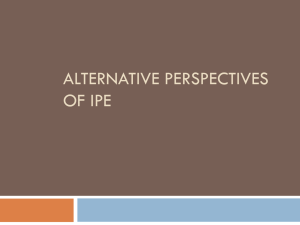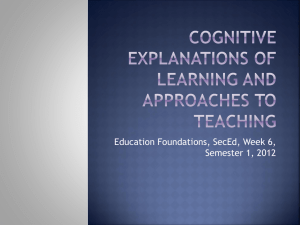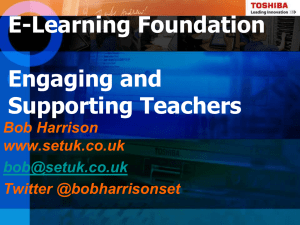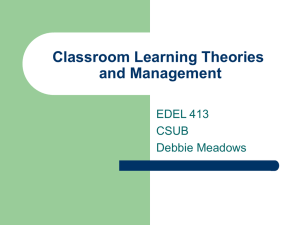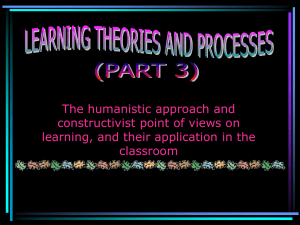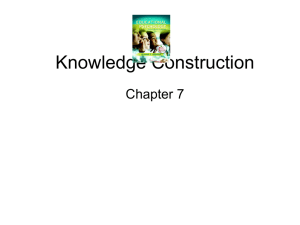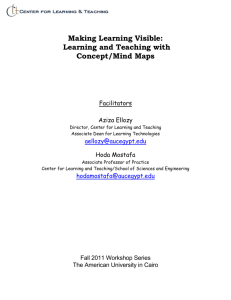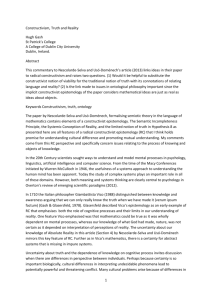Constructivism is a learning theory found in
advertisement
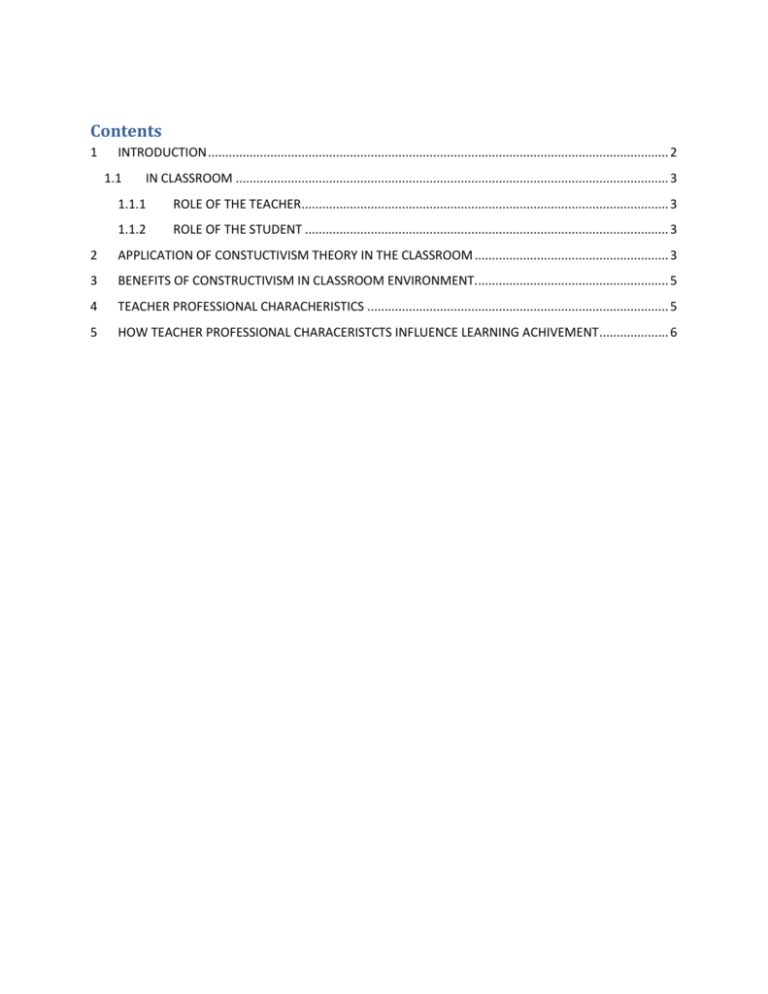
Contents 1 INTRODUCTION ..................................................................................................................................... 2 1.1 IN CLASSROOM ............................................................................................................................. 3 1.1.1 ROLE OF THE TEACHER.......................................................................................................... 3 1.1.2 ROLE OF THE STUDENT ......................................................................................................... 3 2 APPLICATION OF CONSTUCTIVISM THEORY IN THE CLASSROOM ........................................................ 3 3 BENEFITS OF CONSTRUCTIVISM IN CLASSROOM ENVIRONMENT........................................................ 5 4 TEACHER PROFESSIONAL CHARACHERISTICS ....................................................................................... 5 5 HOW TEACHER PROFESSIONAL CHARACERISTCTS INFLUENCE LEARNING ACHIVEMENT .................... 6 In answering this question we started by dividing into three part, the first part is introduction that consist the explanation of key concepts of the question and the following is the main body that explain the application of constructivism in school environment and how teacher professional characteristics can influence students achievement and lastly is conclusion. 1 INTRODUCTION According to Judith, constructivism is the notation that learning is influenced by prior experience and ideas has led to the development of what has become the dominant view of learning in science education today. Constructivist views of learning hold that the people construct their own meaning from what they experience rather than acquiring knowledge from other sources Constructivism is a learning theory found in psychology which explains how people might acquire knowledge and learn. It therefore has direct application to education. The theory suggests that humans construct knowledge and meaning from their experiences. Constructivism is not a specific pedagogy. Piaget's theory of Constructivist learning has had wide ranging impact on learning theories and teaching methods in education and is an underlying theme of many education reform movements. Research support for constructivist teaching techniques has been mixed, with some research supporting these techniques and other research contradicting those results. Constructivism is basically a theory based on observation and scientific study about how people learn. It says that people construct their own understanding and knowledge of the world, through experiencing things and reflecting on those experiences. In classroom the constructivism view of learning can point towards a number of different teaching practices, in the most general sense, it usually means encouraging students to use active techniques of learning such as experiments so as to create more knowledge and to reflect on. Constructivism teacher encourage students to constantly asses how the activity is helping them gain understanding. (Peaget) 1.1 IN CLASSROOM The main activity in a constructivism classroom is solving problems to create more knowledge and then to reflect on and talk about what they are doing and how their understanding is changing. The teacher makes sure she understands the students' preexisting conceptions, and guides the activity to address them and then build on them. Students use inquiry methods to ask questions, investigate a topic, and use a variety of resources to find solutions and answers. As students explore the topic, they draw conclusions, and, as exploration continues, they revisit those conclusions. Exploration of questions leads to more questions. 1.1.1 ROLE OF THE TEACHER Teacher acts as a guide on the side providing students with opportunities to test the capability of their current understands though provision of different activities like, Promote discussion or debate Set up study group for peer learning Show students models of good practice in essay writing and project work Encourage team working collaboration 1.1.2 ROLE OF THE STUDENT In a constructivism learning classroom environment the students play more active roles in and accepts more responsibility for their own learning such as, Participate actively in their own learning Assimilate and accommodate new information with their current understanding Reflect their experience in order to control their own learning understanding 2 APPLICATION OF CONSTUCTIVISM THEORY IN THE CLASSROOM Constructivism maintain an individual`s critical thinking, simply this theory enables students to support their own argument, in real meaning taking responsibility for their own words and respecting those of others, for example the teacher can use open-ended questions and leaving time to allow the students to think and analyze a response based on their experiences and personal inquiry. It allows constant conversation between the students themselves and their teacher. This engagement creates a discussion of comfort in which all ideas can be considered and understood then students feel safe about challenging other hypothesis, defending their own and supporting real world situations with abstract supporting data. For example group discussion learning or method allows the students interact and share their ideas. It provides opportunities for the students to engage themselves in learning process as they create meaningful ant facts. This includes reports, physical model that provide opportunities for the students to demonstrate their understanding. This also use a constructivism approach to learning because students are involve in constructing deep understanding as they engage with the ideas needed for their activity, for example project based learning.(Kalpatric 1918) Students engaging in constructive activities, this method are considered as a constructivist approach to instruct, because in problem solving learning content strategies and self directed learning skills are through collaboratively solving, learning guide’s students by using solving complex problems such as medical diagnosis or designing a play ground. (Barrows, 2000) Students are actively use material or information presented by the teacher to construct meaning. It is responsibility of a student to construct the meaning from the material presented. Students are actively participating in the learning without depending o he teacher. Teacher is just a facilitator of the learning also a teacher should only respond to students efforts to learn the material in order to make sure that student is able to construct the meaning from material presented.(Parkay et al 2006;276) The teacher elicits student’s prior knowledge of the material and uses this as the starting point for instruction. A teacher can set a series of questions in order to test the prior knowledge of the students on a particular topic or matters, this help the teacher to prepare or select the appropriate learning material and strategies depending on their prior knowledge the students have. So the students can use their prior knowledge to construct the meaningful of the new material. 3 BENEFITS OF CONSTRUCTIVISM IN CLASSROOM ENVIRONMENT. i. Children learn more and enjoy learning when they are actively evolved rather than passive listening. ii. Education works best when it concentrates on thinking and understanding rather than on memorization. Constructivism concentrates on learning how to think and understand. iii. Children learn best when they are allowed to construct a personal understanding based on experiencing things and reflects on those experiences. iv. Constructivist learning is transferable, in constructivist classrooms students creates and organizes principles that they can take with them to other learning setting. 4 TEACHER PROFESSIONAL CHARACHERISTICS A. Explain briefly how teacher professional characteristics can influence students learning achievements. The most ambitious investigations into teacher personality and it are relationship o teacher effectiveness was carried out more than 30 years ago. According to Ryan’s, constructed a special “teacher characteristics rating scale” and found that the successful teacher tends to be: Professional knowledge on the subject matter; A professional teacher must be good in subject matter and the flow of ideals, materials must be arranged from low cognitive order to high cognitive also a professional teacher must consider the age, environment and the level of understandings of their students. Personality ; A professional teacher must have a good relationship with their students, member of the staff and society at large. He or she me be honestly, reliable, kindly, friendly, o his or her students/learners that he or she must put much emphasize on the learners needs. That means he or she must be available in and outside the school in order for the learners to get assistance from him or her. Professional attitudes This includes a sense of responsibility, strong moral sense punctuality and appropriate standard of dress, meaning that students describe their teacher from who they have regards, students take good grooming and neat clean clothes as a sign of respect or regard from their teach. Teachers undergo training on teaching strategies and methodologies. They take exams which demonstrate that they have acquired the skills necessary for the teaching professional and thereafter referred to as trained teachers. The teachers have a code 5 HOW TEACHER PROFESSIONAL CHARACERISTCTS INFLUENCE LEARNING ACHIVEMENT The following is how the teacher professional characteristics can influence students learning achievement after discussing teacher professional characteristics above. Teacher create a sense of community and collaboration among the students, parents and teachers, that helps to monitor the progress of the learners in learning process also their behavior in general. So this is very helpfully to the learner because they are going to be active learners and therefore to achieve what they intended to gain. Teacher use a variety of instructional strategies and methods in teaching process to make the learners to understand the intended knowledge, for example participatory based learning this enable the students and teachers to exchange their ideas and to participate fully in learning.(Ornstein 1995:61) Professional teacher identifies and evaluates learning problems of students in order to make improvements in learning process of the students because different problems which can be forced by students can results t negligence of learning or studies. Therefore students or if students participate fully in the classroom can result to students achievements I any subject if there is no anything or facing any problem like economic, family or psychological problems.(Ornstein 1995:61) Teacher plans instruction at a variety of cognitive levels that facilitates the learning and teaching to the students because he or she is going to teach by considering the level of student’s ability of understanding. Teachers are trained in a level that he or she can know how to apply knowledge to recognize and to use cognitive domain during teaching process, this is very helpful to the students or can result for achievements in learning. Teachers have code of regulation and ethics that makes a teacher to be effective and efficiency in teaching process. It also encourages the teacher to be committed and willing on his or her work at any time and any place. This can result achievement to the students or learners because teachers are responsible for their work.



